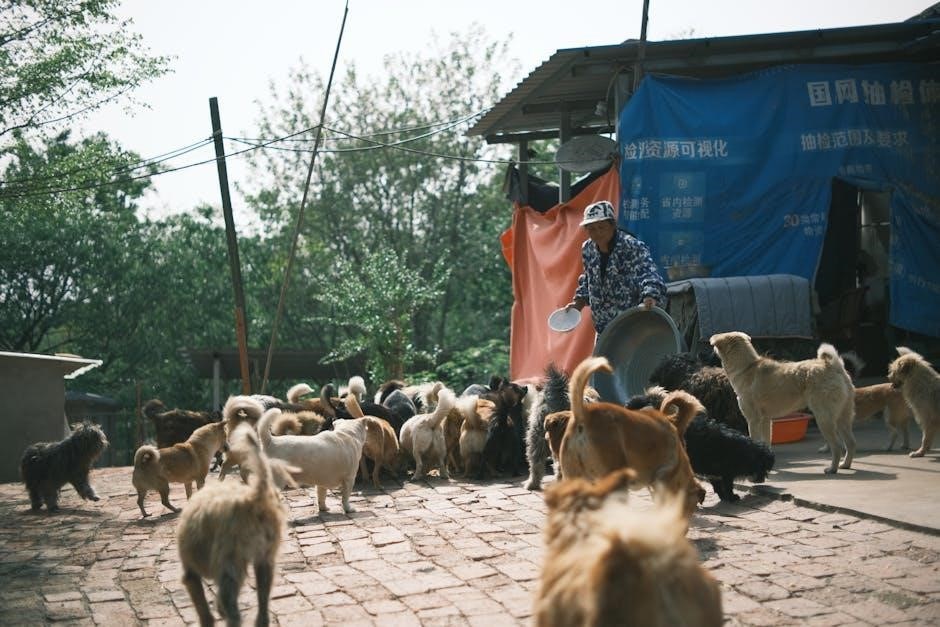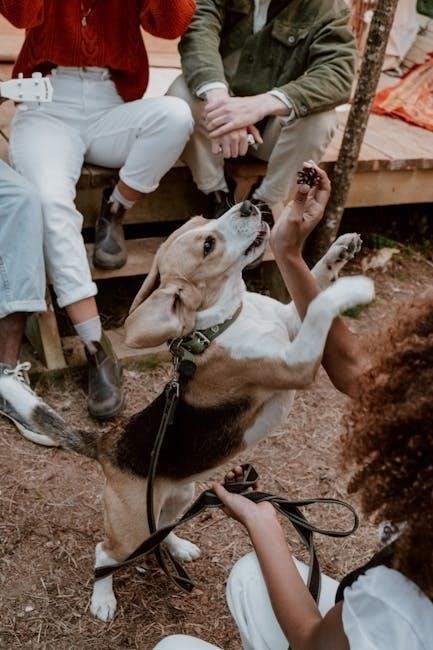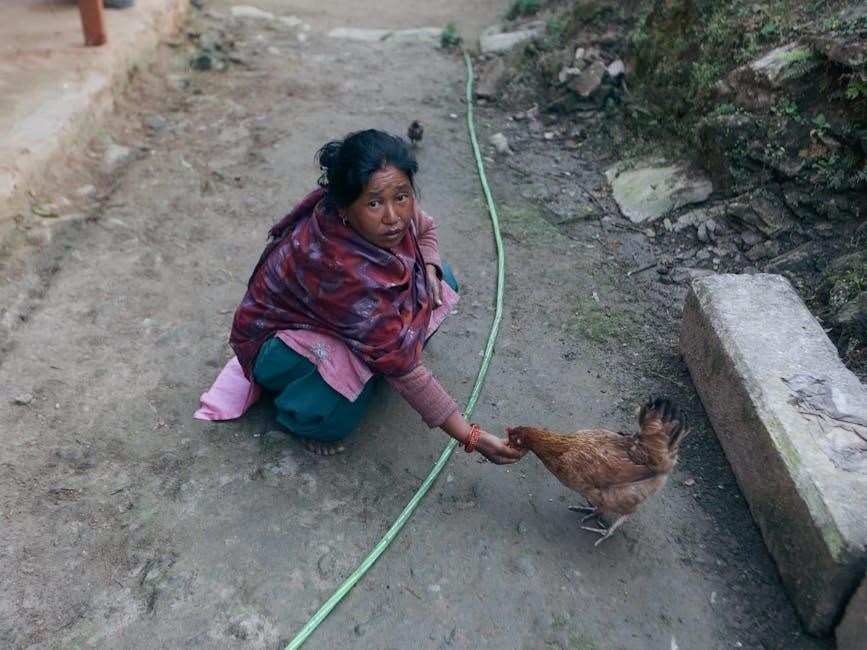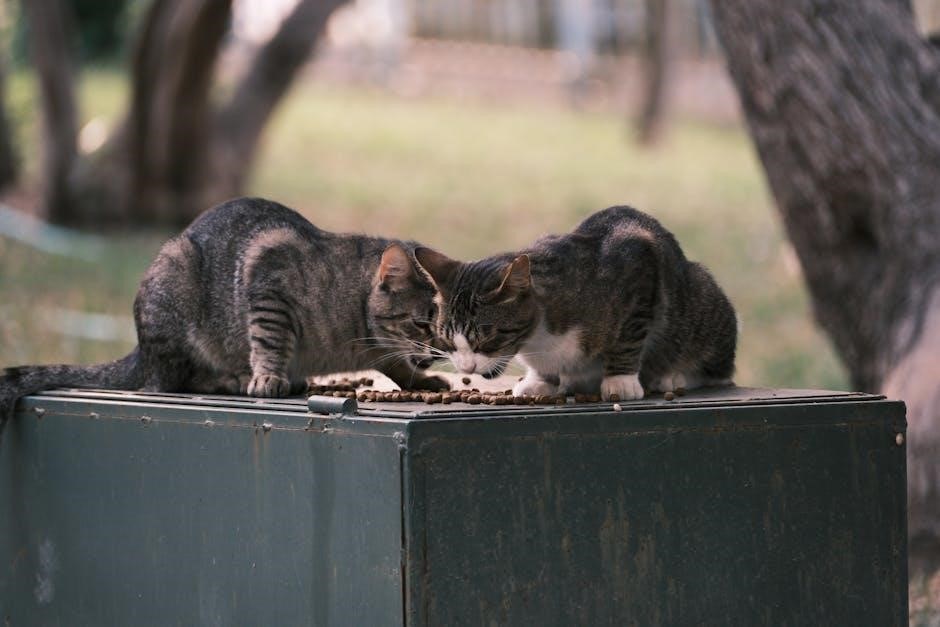
pets go raw feeding guide
Raw feeding is a natural approach to pet nutrition, mimicking what pets would eat in the wild․ It focuses on raw meats, organs, and bones, promoting better digestion, healthier coats, and higher energy levels․ Many pet owners embrace this diet for its perceived health benefits, making it a popular choice for both dogs and cats․ By understanding raw feeding, you can provide your pet with a more biologically appropriate diet․
What is Raw Feeding?
Raw feeding is a dietary approach where pets are fed uncooked, whole foods such as meats, organs, bones, and occasionally fruits and vegetables․ This method mimics the natural diet of wild animals, aiming to provide pets with a biologically appropriate diet․ The raw diet typically includes muscle meat, organs like livers and kidneys, and edible bones, which are essential for maintaining nutritional balance․ It avoids processed ingredients and focuses on fresh, minimally processed foods․ This approach is often referred to as the BARF (Biologically Appropriate Raw Food) diet․ Raw feeding is designed to promote optimal health, digestion, and energy levels in pets, aligning with their evolutionary needs․

Benefits of a Raw Diet for Pets
A raw diet offers numerous health benefits for pets, including improved digestion, healthier coats, and increased energy levels․ It can reduce allergies and skin issues, as it avoids processed ingredients and fillers․ Raw feeding promotes cleaner teeth and fresher breath due to the natural abrasion of bones․ Pets often experience weight management and improved joint health, as raw diets are rich in essential nutrients and free from unnecessary carbohydrates․ Many pet owners also report reduced shedding and a stronger immune system․ Overall, a raw diet aligns with a pet’s natural eating habits, leading to enhanced overall health and vitality․
Key Components of a Raw Diet
A raw diet consists of fresh meats, organs, bones, and occasional fruits or vegetables, mimicking a pet’s natural diet․ It avoids processed ingredients, focusing on whole foods to ensure balanced nutrition․

Meat and Protein Sources
Meat and protein sources form the cornerstone of a raw diet, providing essential nutrients for pets․ Common choices include chicken, turkey, beef, fish, and lamb, which are rich in protein and amino acids․ Organ meats like liver and kidney are also included for their high vitamin and mineral content․ It’s important to use a variety of meats to ensure a balanced diet and avoid nutritional deficiencies․ Fish can be added for omega-3 fatty acids, while red meats provide iron and zinc․ Always opt for fresh, high-quality sources, and consider using named animal parts to ensure clarity and safety․ Avoid fillers and processed meats, focusing instead on whole, raw ingredients to maximize health benefits for your pet․
Organs, Bones, and Supplements
Organs, bones, and supplements are vital components of a raw diet, ensuring nutritional balance․ Organs like liver, kidney, and spleen provide essential vitamins and minerals, while bones offer calcium and dental benefits․ Recreational bones, such as knucklebones, can help reduce tartar and satisfy chewing instincts․ It’s important to include a variety of organs to avoid over-supplementation of specific nutrients․ Supplements like fish oil or probiotics may be added to address potential deficiencies or support digestion․ However, it’s crucial to use them sparingly and under professional guidance․ Always ensure bones are safe and appropriate for your pet’s size to prevent choking or obstruction․ A balanced inclusion of these elements supports overall health and vitality in pets․ Rotate organ types weekly to maintain diversity and prevent nutrient imbalances․ Consulting a vet or nutritionist can help tailor these additions to your pet’s needs․

Transitioning Your Pet to a Raw Diet
A gradual switch to raw feeding is essential to prevent digestive upset․ Start by mixing small amounts of raw food with their current diet, then slowly increase the proportion over 1-2 weeks․ Monitor your pet’s digestion and adjust the transition pace as needed to ensure a smooth adaptation․ Patience is key to helping your pet thrive on their new diet․
Gradual Transition Steps for Dogs
Transitioning your dog to a raw diet should be done slowly to avoid digestive upset․ Start by mixing 10% raw food with their current diet on days 1-2, then increase to 25% on days 3-4․ By days 5-7, aim for 50% raw food․ Continue this gradual increase, reaching 75% raw food by day 10 and 90% by day 14․ Monitor your dog’s stool quality, energy levels, and overall health during this process․ If digestive issues arise, slow the transition․ Introduce one protein source at a time to identify sensitivities․ Ensure all meals are served at room temperature for optimal digestion․ Patience is key, as some dogs may take longer to fully adapt to their new diet․
Transition Tips for Cats
Transitioning cats to a raw diet requires patience, as they can be sensitive to changes․ Start by mixing 10% raw food with their current wet food on days 1-2, then gradually increase to 25% by days 3-4․ Continue this process, reaching 50% raw food by days 5-7 and 75% by day 10․ Serve raw food at room temperature to mimic natural eating habits․ Introduce one protein source at a time to monitor for sensitivities․ Watch for stool quality and energy levels; if issues arise, slow the transition․ Cats may take longer to adapt, so consistency is key․ Avoid leaving raw food out for too long to prevent spoilage․ Ensure fresh water is always available to support digestion and overall health․
Calculating Portion Sizes
Portion sizes for raw diets are typically based on 2-3% of a dog’s body weight and 2% for cats․ Adjustments are made for activity, age, and breed to ensure optimal health and prevent obesity, with puppies requiring higher portions․ Monitoring weight and adjusting intake helps maintain a balanced diet, ensuring nutritional needs are met without overfeeding․
Portion Guidelines for Dogs

Portion sizes for dogs on a raw diet typically range from 2-3% of their body weight daily, depending on factors like age, activity level, and breed․ For example, a 50-pound dog would need about 1-1․5 pounds of raw food per day․ Puppies may require up to 5% of their body weight to support growth․ Divide portions into 1-2 meals for better digestion․ Monitor your dog’s weight and adjust portions to prevent underfeeding or overfeeding․ For precise calculations, consider your dog’s energy needs and consult a vet for personalized advice․ Avoid overfeeding to maintain a healthy weight and reduce obesity risks․ Adjustments may be needed for senior dogs or those with specific health conditions․ Consistency and observation are key to ensuring a balanced diet․
Portion Guidelines for Cats

When it comes to portion guidelines for cats on a raw diet, it’s essential to consider their specific needs․ Typically, cats require about 2-3% of their body weight in raw food daily․ For example, a 10-pound cat would need around 0․2 to 0․3 pounds of food per day․ However, this can vary based on factors such as age, with kittens often requiring more to support growth, and senior cats potentially needing less; The type of raw food, whether it includes bones and organs, can also influence portion sizes․ Feeding smaller, more frequent meals may aid digestion, but it’s crucial to avoid overfeeding to maintain a healthy weight․ Monitoring your cat’s weight and adjusting portions accordingly is advisable․ Consulting a veterinarian knowledgeable in raw diets can provide personalized guidance tailored to your cat’s specific needs․
Raw feeding requires careful handling to avoid bacterial contamination․ Always use high-quality ingredients, store food properly, and maintain hygiene to reduce health risks for both pets and humans․

Safety Considerations
Handling and Storage Tips
Proper handling and storage are crucial for maintaining the safety and quality of raw pet food․ Always store raw meals in sealed containers or freezer-safe bags to prevent contamination and spoilage․ Thaw frozen food in a covered container in the refrigerator or cold water to avoid bacterial growth․ Keep raw food separate from other foods to minimize cross-contamination․ Wash hands thoroughly before and after handling raw ingredients, and clean all utensils and surfaces with a pet-safe disinfectant․ Store raw food in the freezer for up to 3-4 months and in the refrigerator for no more than 3-4 days․ Label and date all stored portions for easy rotation․ Proper storage ensures freshness and reduces the risk of foodborne illnesses, keeping your pet safe and healthy․
Safe Bones and Chews
Feeding pets raw bones and chews can be beneficial for dental health and satisfaction, but safety is paramount․ Choose raw, meaty bones like knucklebones or marrow bones, as they are less likely to splinter․ Avoid cooked bones, as they can become brittle and harmful․ Supervise your pet during meal times to ensure they chew bones safely․ For cats, opt for smaller, softer bones or chicken necks to prevent choking․ Recreational chews like bully sticks or rawhide alternatives can also be safe options if sourced from reputable brands․ Always select chews appropriate for your pet’s size and chewing style․ Rotate bones and chews to prevent boredom and ensure variety․ Remember, not all bones are safe, so consult your vet for recommendations tailored to your pet’s needs․

Cost and Budgeting
Raw feeding can be cost-effective with proper planning․ High-quality raw ingredients vary in price, but bulk purchases and rotating protein sources can help manage expenses efficiently․
Estimating Monthly Costs
Estimating monthly costs for raw feeding requires considering your pet’s size, activity level, and dietary needs․ On average, dogs may cost $50–$100 per month, while cats range from $30–$70․ Factors like protein sources and supplement additions can influence expenses․ Buying in bulk and rotating protein sources can help reduce costs․ Pre-made raw diets are convenient but often pricier than DIY options․ Planning meals in advance and using affordable cuts of meat can make raw feeding more budget-friendly․ Additionally, costs may vary based on your location and availability of raw ingredients․ Tracking your pet’s consumption and adjusting portion sizes can help optimize spending․ Consulting with a vet or nutritionist can provide tailored budgeting advice for your pet’s specific needs․

Managing Expenses
Managing expenses for raw feeding involves strategic planning and budgeting․ Buying ingredients in bulk, such as meats and bones, can reduce costs․ Planning meals ahead and using seasonal or locally sourced products can also save money․ Consider rotating protein sources to avoid relying on expensive options․ Supplements can be added in minimal quantities to keep costs low․ Investing in a freezer for storage allows you to stock up during sales․ Additionally, consulting with a pet nutritionist can help tailor diets to your budget while ensuring nutritional balance․ While raw feeding may seem costly, many pet owners find it cost-effective in the long run due to improved health and reduced vet visits․ Tools like budgeting apps or spreadsheets can help track and manage expenses effectively․
Raw feeding offers a natural and nutrient-rich approach to pet nutrition, aligning with the eating habits of wild animals․ By focusing on raw meats, organs, and bones, this diet promotes healthier digestion, shinier coats, and increased energy levels․ Many pet owners have embraced raw feeding due to its potential health benefits, making it a popular choice for both dogs and cats․ To ensure success, proper planning, research, and consultation with veterinarians or pet nutritionists are essential․ While raw feeding requires effort and understanding, it can lead to noticeable improvements in your pet’s overall well-being․ Always prioritize safety, balance, and your pet’s individual needs when transitioning to or maintaining a raw diet․